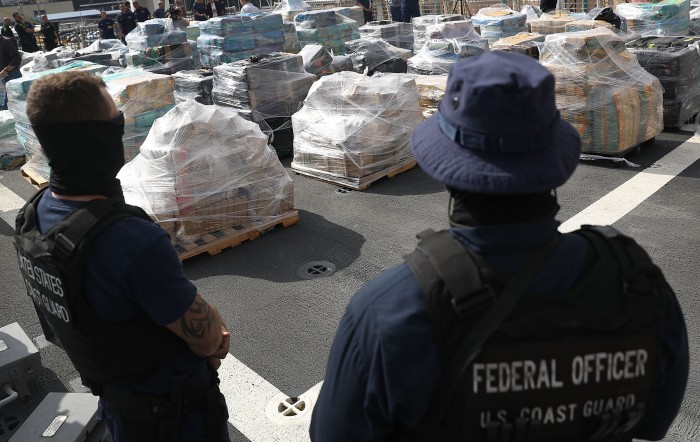How Do You Fight the Largest Cocaine Boom in History? With Drones.
In Colombia, the coca crop is bigger than ever, and cocaine is being shipped out of the country as never before.

With the boom in production—an estimated 710 metric tons of cocaine in 2016—it may not be surprising that a record amount is also being seized on the high seas on its way to the American market. Last year, the U.S. Coast Guard confiscated 221 metric tons of the stuff, a record.
But the Coast Guard believes that for every one drug-trafficking boat it tracks down, four make it through. So with six million square miles of ocean to patrol in the Eastern Pacific, the Caribbean, and the Gulf of Mexico, and just five big ships to work with, the agency is turning to technology to help expand its reach.
On a two-week stay aboard the Coast Guard cutter Stratton as it cruised off the coast of South America in the Pacific Ocean, a reporter with the Associated Press observed the first deployment of a ScanEagle drone for drug interdiction.
It didn’t take long for the drone to have an impact. On the second day of operations, it spotted a suspicious craft. A small boat launched from the Stratton intercepted it, and it yielded without a fight, turning over 700 kilograms of cocaine in the process. On the street, that could sell for over $100 million.
Turning coast guard ships into drone-toting aircraft carriers could do plenty to enhance their effect at sea. And such a force multiplier is needed—in a report in March, the U.S. Department of State estimated that 97 percent of the cocaine that enters the country is first smuggled out of South America on “noncommercial maritime conveyances,” which include everything from fishing boats to homemade submarines.
Colombia, meanwhile, is facing the largest coca crop in history. In 2015, the Colombian government shut down aerial spraying of herbicides meant to eradicate coca amid concerns that exposure to glyphosate (aka Roundup) was leading to increased cancer rates. Farmers also raced to plant coca so that they could qualify for a government program that richly rewards growers who agree to rip up their plants. As a result, the area under cultivation grew massively, to an estimated 465,000 acres in 2016.
It seems unlikely that technological solutions could stop so much cocaine from making it to market entirely. As the Washington Post notes, despite the record seizures, the drug’s street price has crashed, suggesting that lots of supply is still getting through.
Then again, who knows—the Coast Guard’s drug-fighting drone program is only just getting off the ground.
(Read more: Associated Press, The Washington Post, “The Dark Origins of the Gold in Your Smartphone,” “For Cocaine Addicts, Treatment with Magnets May Stop Craving”)
Keep Reading
Most Popular
Large language models can do jaw-dropping things. But nobody knows exactly why.
And that's a problem. Figuring it out is one of the biggest scientific puzzles of our time and a crucial step towards controlling more powerful future models.
The problem with plug-in hybrids? Their drivers.
Plug-in hybrids are often sold as a transition to EVs, but new data from Europe shows we’re still underestimating the emissions they produce.
How scientists traced a mysterious covid case back to six toilets
When wastewater surveillance turns into a hunt for a single infected individual, the ethics get tricky.
Google DeepMind’s new generative model makes Super Mario–like games from scratch
Genie learns how to control games by watching hours and hours of video. It could help train next-gen robots too.
Stay connected
Get the latest updates from
MIT Technology Review
Discover special offers, top stories, upcoming events, and more.